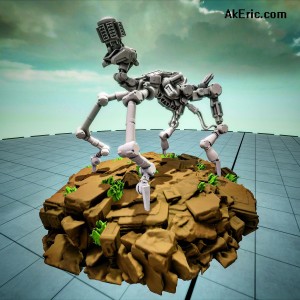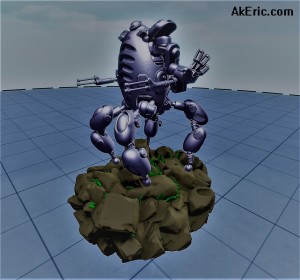Customizing Oculus Medium
Over the holidays I picked up an HTC Vive, and the first thing I did was jump into Google Tiltbrush and Oculus Medium : Both awesome VR painting apps, both very different. This post will collect my (ongling) notes on Medium.
Table Of Contents
First tests
Here’s a couple of kitbashed robots that took me about three hours. So much fun!
Installation
To get Medium working on my Vive, I had to setup an Oculus account (+ purchase Medium) and install “Revive” : Both painless.
Documentation
Mapping the Oculus controllers to the Vive
At first I had a lot of trouble trying to figure out which Vive buttons mapped to the virtual Oculus controllers. Couldn’t get anything to reliably work. I finally read you just touch on the thumbpads where the corresponding Oculus buttons are, and it ‘just worked’. Suddenly became usable.
Installing custom brushes
You can install your own custom brushes in Medium. Here are the rules (many pulled from the above FAQ):
- Must be saved as .obj
- Must be triangulated.
- They need to be saved here:
-
C:\Users\USERNAME\Documents\Medium\_Import\Stamps
-
- In Medium, open the Main Menu, navigate to the personal tab, and select Stamps. At the bottom of the window, you’ll see an import button.
- They’ll then show up in the ‘Custom’ stamps section.
- Should be as low-poly as possible.
- Scale doesn’t appear to matter: I made test with different sized models. My guess is that Medium auto-scales them to fit some standard sphere that is used on the brush.
Medium’s coordinate system
I did some test by bringing in three different cones into Medium each build along a different axis. I was able to then reverse-engineer the coordinate system relative to the sculpt tool. You can use these notes when building your own brushes, to make sure they show up in Medium correctly.
I made a handy infographic:
X is towards you, Y is towards the controller, and Z is up.
This also means that when you create stamps that you want to project onto another surface, you should orient them so that their ‘up’ vector aligns with the +Z worldspace axis in your 3d software. This will thus orient them properly onto the surface in medium.
Performance Issues
I’m running a GTX 1080 GPU, i5 CPU, 32 gigs of ram : The software will definitely stutter if I paint large items, or paint quickly. If I paint one stamp at a time it doesn’t seem to be a problem. Also seems to loose tracking far more often than other software: I can watch the sculpt hand just ‘float away’ sometimes.



Thanx for the article , really helpful.
however i have one question, what polycount “GL” number range should each kitbash stamp be?
I myself don’t know: I do know from experimentation, that the lower the better, for performance reasons, at least based on my setup. But I have no hard numbers.
Then… you mean oculus touch is left hand coordinate right? where can we find that correct information??
Sorry i mean right hand coordinate : )